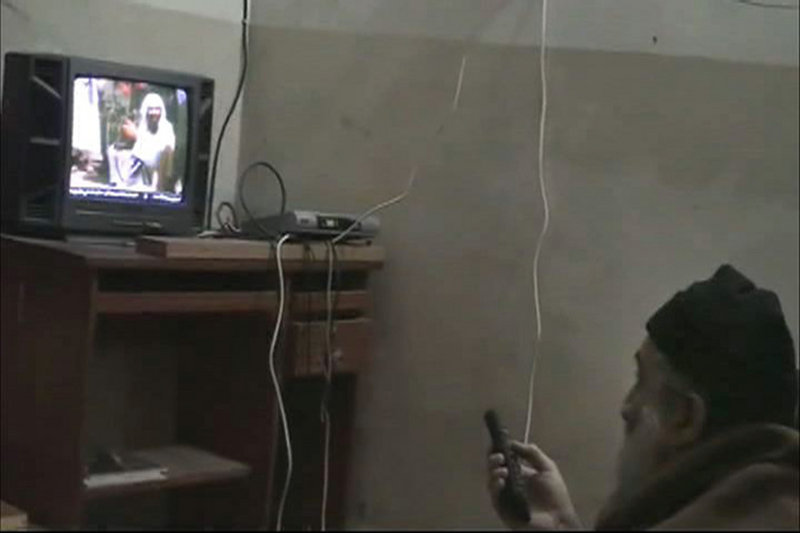Osama bin Laden was preoccupied with attacking the United States over all other targets, a fixation that led to friction with followers, according to U.S. intelligence officials involved in analyzing the trove of materials recovered from the al-Qaida leader’s compound.
In handwritten journals and long-winded compositions saved on computer hard drives, the officials said, bin Laden always seemed to be searching for a way to replicate the impact of al-Qaida’s most devastating strike.
He exhorted followers to explore ways to recruit non-Muslims “who are oppressed in the United States,” in the words of one official — particularly African Americans and Latinos — and to assemble a plot in time for the 10th anniversary of the Sept. 11 attacks.
Even while sealed inside a cement compound in a Pakistani city, bin Laden functioned like a crime boss pulling strings from a prison cell, sending regular messages to his most trusted lieutenants and strategic advice to far-flung franchises, including al-Qaida’s affiliate in Yemen. Some followers pledged their fealty to him; others, however, chafed at his exhortations to remain focused on U.S. targets instead of mounting less risky operations in places such as Yemen, Somalia and Algeria.
“Bin Laden is saying, ‘You’ve got to focus on the U.S. and the West,’” said a senior U.S. intelligence official who was involved in reviewing the stockpile, adding that some of bin Laden’s followers seemed more concerned with regional issues and were reluctant to conduct an attack that would provoke an American response.
Little over a week after obtaining one of the largest intelligence hauls on a terrorist group, U.S. officials involved in reviewing the trove said they are learning more about bin Laden and the al-Qaida bureaucracy than about the locations of operatives or specific plots that might be unfolding.
Over all, the officials said, the new information — as well as the lack of any apparent effort by bin Laden to prevent it from falling into U.S. hands — provides a strikingly rich portrait of the al-Qaida chief.
“Bin Laden got lazy and complacent,” said the senior U.S. official, who spoke on the condition of anonymity because of the sensitivity of the information. “I don’t think he thought he would meet his maker in that house. And he certainly didn’t make any preparations” to escape a raid or destroy the information found inside, the official said.
Officials said they are still in triage mode as they sift through the contents of more than 110 flash drives, laptops and other digital storage devices, in addition to piles of paper documents. The trove, which represents millions of pages that must be translated from Arabic, is being scrutinized at a secret CIA facility in Northern Virginia. Analysts and Arabic linguists from other agencies are being brought in to review the materials.
The early effort has focused on searching the most recent materials for keywords, including the names of major American cities. Analysts are also scanning for references to names of al-Qaida figures, phone numbers and other details that could provide clues for CIA operatives and military counterterrorism teams working overseas.
U.S. officials said bin Laden had a relatively short list of senior al-Qaida members whom he was in touch with frequently and directly, albeit through messages smuggled out of the compound by couriers.
Among them are Ayman al-Zawahri, the Egyptian physician who has long functioned as bin Laden’s second in command, as well as Atiyah Abd al-Rahman, a Libyan operative who is the latest to fill the organization’s vulnerable No. 3 slot.
Bin Laden’s directions tended to be big-picture in nature, officials said, focusing more on broader objectives than on granular operational details. “I wouldn’t call it command and control” that bin Laden was exercising, the senior U.S. intelligence official said. Indeed, there is no indication that bin Laden even knew the specific whereabouts of Zawahri and others. Al-Qaida’s fragmented nature and operational security appear to have kept its leader substantially in the dark.
“We’re not going to find operational manuals or Excel spreadsheets” with rosters of operatives and points of contact, the senior intelligence official said. Bin Laden served as a “chief executive who is giving fairly generic, broad instructions and guidance rather than tactical orders,” the official said.
Even so, the communications are expected to help the CIA and other organizations, including the National Counterterrorism Center, gain significant insights into al-Qaida’s structure and relationship to regional affiliates.
The U.S. intelligence official said bin Laden’s records have “confirmed our view that AQAP is first among equals in terms of relationships with al-Qaida core.” The acronym refers to al-Qaida in the Arabian Peninsula, the Yemen-based group that is behind a series of plots targeting the United States, including the attempted bombing of a Detroit-bound airliner on Christmas Day 2009.
Send questions/comments to the editors.


